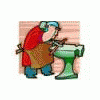-
Posts
922 -
Joined
-
Last visited
Content Type
Profiles
Forums
Articles
Gallery
Downloads
Events
Posts posted by keykeeper
-
-
BAH....DUMPH.....BUMMP.
(Sorry, Couldn't resist.) -
-
20+ deer. Is that all?
I can hit that many with my truck in one evening, if'n I want to.
The new state motto here should be "Deer Heaven, West Virginia" instead of "Almost Heaven".
If I'm out in my shop after dark, they walk up and see what I'm doing in there.
And I live IN town.
-aaron c. -
I would say about four 55 gallon drums would hold a ton, depending on how tight it's packed in them. Five for sure. I don't know the measurements for a ton cubic-ly speaking, but I would use drums with lids on them. They would keep it dry and clean. As long as the coal is dry to begin with. Easily moved with a heavy dolly wherever you would need them. Or just roll them with a little help, as long as the lids are secure. When you get a new shop, then build a new bin to hold it all there. I'm sure other more experienced smiths will chime in from their experiences.
Just my .02 worth.
-aaron -
Re: Shift Linkages and Fabrication
I have a friend that fabbed a shift linkage from stainless hexagonal (I think) stock. I believe he also engraved the flats. Then he twisted it, if I'm not mistaken.
Just some ideas for you.
I'll try to get a photo from him to post. -
Beautiful work, Jose. Sometimes it's the small things that make the biggest difference in improving a persons quality of life.
Ya did good.
-aaron c. -
Richard,
I will have to scan some pages from the 1908 catalog also. COMPLETE blacksmithing setups for less than $100.
Wish I could go back in time.
-aaron c. -
-
Looks like one of the Hay Budden anvils made for one of the hardware companies as detailed in Anvils In America, p.288-289
By those pics it looks like it the hardware company name (note what looks like "CO."), then "SOLID WROUGHT" (note the ".UGHT) then Warranted, similar to some of those pictured in the book.
Shape matches those in AIA for those also. That would date it late 1890's-early 1900's.
-aaron c. -
Nice work you did there Sam. I like those handles, look like they would grip just right for a multitude of hand sizes.
-
I guess you could also forge out one with a long, slender tang on it. Then mount it similar to a hidden tang knife, only in a shaft. I would still pin it for keeping it secure to the shaft.
-
Ok, I said I wouldn't post anymore in this thread, but I'm going to anyway.
We had a discussion about a cat's head hammer early in the thread. Well, I have found the proper name of this hammer, thanks to a reprint of an old Sear's and Roebuck catalog I was reading recently.
According to that catalog, the hammer is a farrier's turning hammer, Chicago pattern. So now we know the real name.
I'm still gonna call it a cat's head though, as I have seen so many people refer to them as that!
-aaron c. -
Forge the first 2/3 (pointed end) out into the spear head. Use the last 1/3 of the spike, minus the head, to forge a socket. Just forge out a triangular shape, then wrap around a mandrel to form a cone shape. Weld the seam shut on the mandrel. Attach to shaft using rivets through.
-
Great for you, Rob. Ya did good.

Enjoy.
aaron -
Glad everyone and everything is alright.
Take care and God Bless.
-aaron -
Nice anvil, IMHO. Should serve you well. However, I can give it a new home, if you want to sell it.

I'm not that far away, either. -
-
My deepest condolences on your loss, Habu. God bless and keep you.
aaron c. -
Now that's funny!
-
70 pound Vanadium Steel,
Located and purchased locally (the fellow brought it to me to look at),
Using the TPAAAT, before I had even heard of it.
$50 in Summer 2006
Good Condition, few dings on the face
Was a painted lady-painted black with white highlights on the letters. Seller was gonna use it for decoration in his house.! -
There's another member, T-Gold in Hawaii. Kaneohe is what's on his posts, maybe you're close to him?
-
An ACETYLENE torch is not efficient for forging. The fuel costs are somewhat prohibitive. A LOT of heat would be wasted in the process. Also, there is a danger of the acetylene becoming unstable, due to release rate from the tank. Search the site, there has been a lot said about acetylene safety here.
-
Prayers are in for a speedy recovery for you, Jimmy. All the best to you Mary as well, in these, I'm sure, trying times. Keep us informed of Jimmy's progress.
-aaron c. -
Glenn, should you follow your own location advice? IForgeIron at Big Chimney is not very obvious...
There IS a Big Chimney in WV. Look it up.
(Not to mention Glenn has a "big chimney" on one of his forges.
Frogpond: See, you are correct.




FS Anvil and swage block
in Anvils, Swage Blocks, and Mandrels
Posted
spreep: Maybe you should post in the tailgaiting section of the site. Wouldn't hurt to read the rules posted at the beginning of the threads as a sticky note, either.
People can't be serious about their interest if there are NO details, and NO price stated.
Also, I hope this isn't an attempt to get a price guideline for your anvils and swage block.
Are you a blacksmith by chance, or an antique-r?
On second thought, I'm serious, I'll give you $20.00 for the lot, you pay the shipping. Just kidding.;)